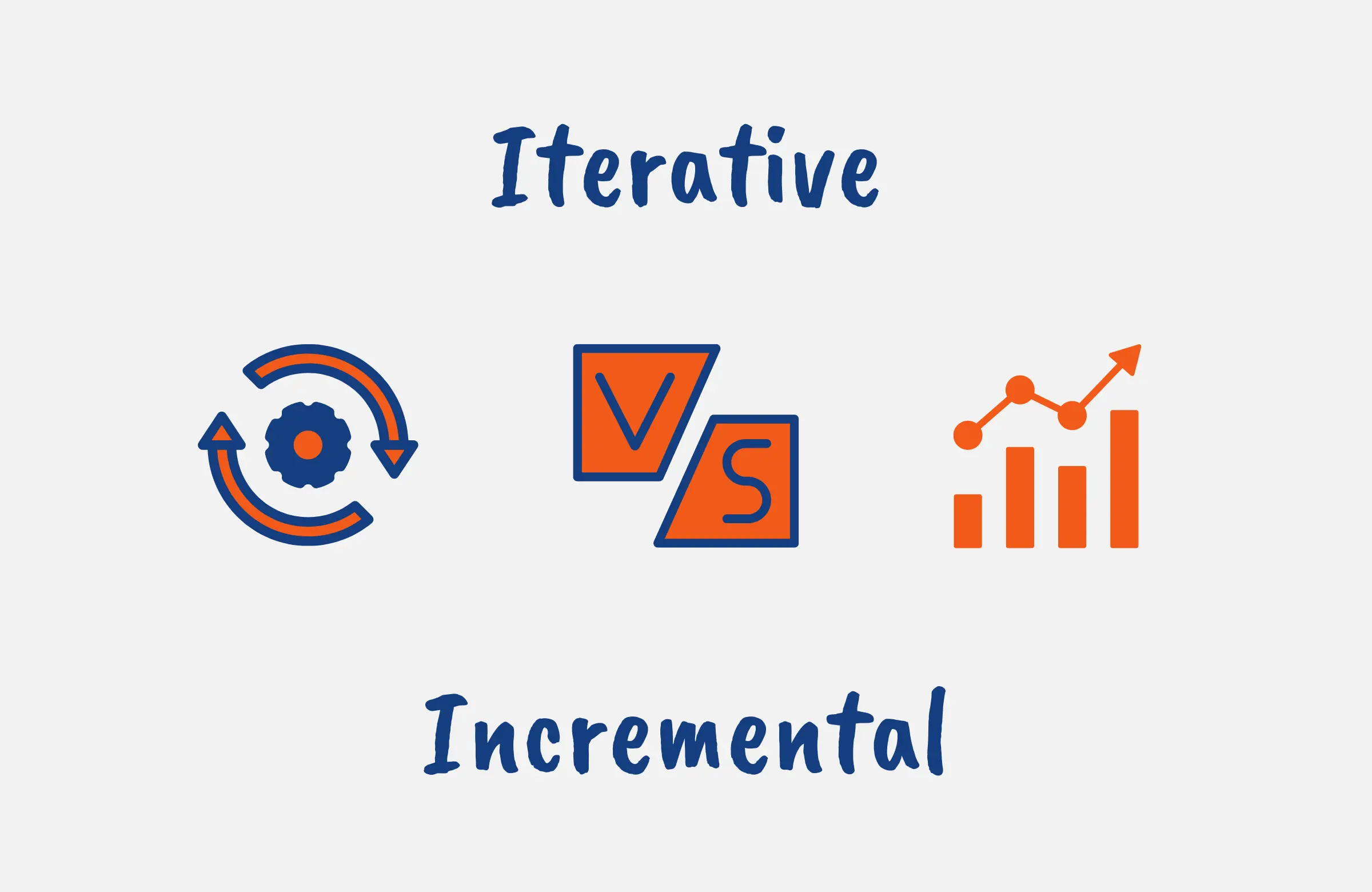For a new software development project, one of the first decisions you face is choosing the approach or methodology to use.
The most common choices lie between incremental and iterative development approaches. Or perhaps a hybrid which is a combination of both. Either of these approaches has its merits depending on the context and constraints.
In this article, we’ll compare incremental vs iterative development methodologies to understand their differences, as well as when to use either of them or a combination of both.
By understanding these methodologies, you can determine the right strategy for your software project based on your requirements, resources, and need for flexibility.
What is the Difference Between Iterative and Incremental Model?
The main difference is that iterative development involves revisiting and refining the same product in cycles, while incremental development builds the product piece by piece, with each piece adding to the functionality.
Iterative focuses on improving the product as a whole, while incremental delivers partial solutions in stages until the full product vision is realized.
The Incremental Development Model
Incremental development involves breaking a project down into smaller, manageable increments that are developed and delivered individually with each increment building on those before it.
This way, the product functionality keeps expanding with each new increment which is self-contained and adds distinct functionality to the overall project.
For example, an initial increment might focus on core functionality, with later increments adding advanced features and enhancements.
The essential characteristic of incremental development is that the product remains fully functioning after each increment ensuring that high-priority features are delivered early on, even if not every planned capability is included yet.
Incremental development is well suited for managing risk since risky or complex components can be isolated into separate increments that won’t block the entire project.

The Iterative Development Model
Iterative development involves gradually building up features through repeated cycles and revisions.
In this approach, rather than planning everything upfront, iterative development takes an incremental approach to building features with each iteration improving on the last.
The development cycles are iterative in nature, with testing and feedback driving refinements in subsequent iterations with no long-term project plan.
A key aspect is releasing working software frequently in order to get feedback which allows the team to continuously improve and refine the product.
This flexible methodology focuses on adaptable designs and rapid prototypes and is well-suited for complex projects with unclear requirements that are likely to change with the cyclical process allowing for emerging requirements.

Incremental vs Iterative Development: Feature Comparison
Incremental and iterative development models both deliver software in stages but take slightly different approaches.
While the incremental develops vertical slices through strict plans, the iterative takes a flexible horizontal approach guided by continuous feedback.
Some key differences between the incremental and iterative development approach include:
1. Upfront Planning
Incremental development requires extensive upfront planning to define the capabilities, scope, and sequence of each increment before coding begins. This ensures a predictable, structured process from start to finish.
Iterative development takes a more flexible approach with less detailed upfront planning.
High-level requirements are defined but the specifics emerge through collaboration and prototypes during each iteration with the focus on responding to feedback through change.
2. Release Frequency
The incremental approach releases less frequently, typically when each major increment is complete and tested allowing for rigorous quality assurance on each increment before releasing it.
Iterative development on the other hand releases new iterations as frequently as possible, sometimes even weekly or monthly. The goal is to get fast feedback to drive continuous improvements in quality and design.
3. Change Embracement
Incremental development resists changes to requirements once increments have been planned since this can delay the overall project plan and schedule.
Iterative development embraces change at the end of each iteration, using feedback and lessons learned to steer the next iteration. The process is designed to be adaptable.
4. Feedback Usage
Incremental development gets stakeholder feedback primarily at the end of each increment to assess satisfaction before planning the next increment.
For iterative development, feedback is welcome throughout as it relies heavily on user feedback from each iteration to adjust designs and plans for future iterations.
5. Team Experience
An incremental development approach works well for teams with less Agile experience that benefit from a structured, linear approach with clear plans.
Iterative relies on a mature Agile mindset across the team. Developers must be comfortable with ambiguity, frequent changes, and actively seeking feedback.

Pros and Cons of Incremental Development
While incremental development brings predictability, it lacks flexibility and works best when requirements are clearly defined.
Pros
- Predictability: With detailed upfront plans, incremental development allows for predictable scheduling, release dates, and project timelines.
- Risk Management: Risky, complex components can be isolated into separate increments to avoid blocking the entire project.
- Ease of Testing: Each fully completed increment can go through rigorous quality assurance and testing before release.
- Cost Efficiency: The incremental approach allows focusing budget and resources on high-priority features first.
- Clear Documentation: Comprehensive documentation is created upfront for each increment.
Cons
- Limited Flexibility: Changes become difficult once increments are planned and development has started, limiting agility.
- Rigid Structure: The linear, segmented workflow is less adaptive when compared to iterative approaches.
- Upfront Planning: Comprehensive plans for the entire project are required at the start, allowing little room for emerging requirements.
- Staged Feedback: Feedback is primarily gathered after each increment rather than continually.
- Cascading Delays: A delay in one increment can end up delaying the entire project timeline.

Pros and Cons of Iterative Development
Iterative development provides flexibility but lacks predictability and suits complex projects with unclear requirements more likely to change.
Pros
- Flexibility: Iterative development embraces changing priorities and new information by fluidly adapting the product each cycle.
- Frequent Feedback: Regular iterative releases allow for continuous user feedback to guide ongoing development.
- Continuous Improvement: Each iteration incrementally improves upon the last based on user feedback and testing.
- Fail Fast: Building minimal viable prototypes quickly allows for identifying any flawed assumptions or risky elements early.
- Emergent Requirements: Iterative development allows incorporating new user stories and requirements throughout development.
Cons
- Scope Creep: The flexibility and lack of detailed upfront plans can lead to uncontrolled growth in scope and feature creep.
- Hard to Estimate: With an evolving product and flexible timeline, project budgets and timelines can be harder to accurately estimate.
- Time-consuming: The continual iterative cycles require time for repeated testing, refinement, and integration.
- Fragmented Focus: Some critics believe iterative causes fragmented focus by constantly changing direction each cycle.
- Less documentation: Comprehensive documentation often lags behind the rapid iterative changes.

Using Both Together: The Hybrid Development Model
While incremental and iterative models are often presented as opposites, there are benefits to blending both approaches. Balancing both approaches combines the best of predictability and flexibility.
A hybrid approach typically uses incremental releases containing features built using iterative methods. Larger increments are planned but developed flexibly.
The product is still delivered in complete, incremental releases on a structured schedule maintaining predictability while allowing agility within each increment.
However, iterative Sprints are used to work on features within an increment, with continuous feedback and adjustments during each Sprint.
For example, a team could employ 2-week iterative Sprints to build features, followed by incremental releases every 3 months to deliver working versions.
The optimal blend depends on the project. More uncertainty suggests more iterations between incremental releases, while clearer requirements allow for longer increments.
When to Use Iterative vs Incremental Development
There are several important factors to weigh when deciding between an incremental or iterative approach for a software project.
It’s important to consider all these dynamics to determine the right balance of flexibility and structured plans.
Some key ones are:
1. Project Size and Complexity
For large, complex projects with many unknowns, an iterative methodology allows for uncertainty and emerging requirements.
Smaller, simpler projects can benefit from the predictable structure of incremental development.
2. Clarity of Requirements
If product requirements are clearly defined and stable, incremental development works well for systematically addressing them.
When requirements are unclear or likely to change, iterative allows starting with a high-level vision and refining requirements through each cycle.
3. Team Expertise
Incremental development suits teams with less Agile experience that will benefit from a structured, linear approach with clearly defined plans and phases.
Iterative requires a highly experienced Agile team comfortable with ambiguity, rapid changes, prototyping, and soliciting constant user feedback.
4. Available Resources
Iterative development gives the flexibility to adapt feature scope and priorities to accommodate constraints like reduced staffing.
Incremental makes planning and allocating resources and budgets easier by providing predictable phases.
5. Timelines and Release Cadence
For projects with faster time-to-market needs, incremental development prioritizes delivering core features first.
Iterative on the other hand is better suited for projects with longer time horizons and flexibility.
6. Organizational Culture
If the broader organizational culture expects predictability, linear process, and structured planning, incremental will align better.
More Agile-minded cultures that prioritize rapid adaptation embrace iterative methods.
Iterative vs Incremental PMP Exam Tips
In the PMP exam, you will encounter questions about different project management methodologies.
A strong understanding of iterative and incremental development is particularly crucial.
Here are some tips to help you navigate these questions.
- Identify the Characteristics: Distinguish between iterative and incremental development based on their characteristics. Iterative development involves repeated cycles and continuous refinement, while incremental development focuses on delivering fully functional, independent parts sequentially.
- Understand the Context: Carefully read the context in which the methodology is applied. For instance, a project that requires flexibility and continuous improvement would likely use iterative development, while a project that aims to deliver usable outputs at the end of each phase might choose incremental development.
- Manage Changes and Risks: Be aware of how these methodologies handle change and risk. Iterative development can easily incorporate changes and detect potential issues early, but incremental development, due to its sequential nature, might be less flexible in accommodating changes.
- Apply PMBOK Guide Principles: The PMBOK guide provides comprehensive insights into these methodologies. Make sure you are familiar with how they align with the guide’s principles.
Conclusion
When choosing between incremental and iterative development methods, analyze your project requirements, team capabilities, and organizational needs to determine the right balance of structure and flexibility.
Both approaches have merits depending on the context. With careful planning, you can utilize the strengths of each to deliver value quickly while adapting to change.
FAQs
Is Agile Development Incremental or Iterative?
Agile development is generally considered iterative, with continuously evolving features through rapid cycles and constant feedback. However, Agile can utilize incremental releases as well to deliver value predictably.
What is an Example of Iterative and Incremental Development?
A common example is using 2-week iterative Sprints to develop features, followed by larger 3-month incremental releases deploying the accumulated features. This blends both approaches.
Is Scrum an Iterative or Incremental?
Scrum is an iterative framework, with fixed-length Sprints rapidly building features using continuous feedback and adjustments without long-term planning.
Is Kanban Iterative or Incremental?
Kanban is primarily an iterative method, focused on continuous delivery of new features without fixed sprints or phases. But Kanban projects can still utilize incremental releases.
Which is a Good Example of Incremental Approach?
Spotify used an incremental approach in its development. They initially launched a basic music streaming application.
Over time, they incrementally added features like personalized playlists, podcast support, and social sharing, thereby enhancing user experience and expanding their service.
What is an Example of an Iterative Program?
Prototyping and releasing minimal viable products quickly, then refining based on user feedback in repeated cycles, demonstrates iterative programming.
What is an Example of Iterative Innovation?
Releasing an early beta mobile app, and then rapidly improving it through monthly iterative updates responding to customer feedback, enables iterative innovation.
What are the Five Iterative Development Process Steps?
The core iterative process steps are: identify requirements, design prototype, develop/code, test, review, and refine.
What is the Value of Incrementally Building and Programming Solutions?
Incremental development delivers working software frequently, and each increment adds functionality enabling user feedback to refine requirements.
Shorter iterations adapt to change, reduce risk, and get products to market faster enabling continuous delivery of value to customers early and often.





